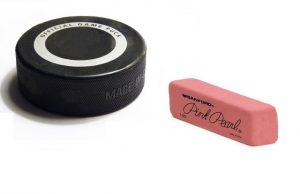Some engineers and buyers already know which type of rubber they need for sealing and insulation. Others may ask if rubber comes in colors other than black (yes, it does), or specify an elastomer that costs too much or won’t meet their application requirements.
Material scientists can spend their entire careers learning about rubber. Engineers and buyers don’t have time for such as singular focus. That’s why Elasto Proxy, a custom-fabricator of industrial rubber products, brings you this list of five things you need to know about rubber:
- Durometer and compression drive seal performance
- Chemical resistance can be critical – and complicated
- Environmental resistance supports longer service life
- Rubber parts have different tolerances than metal parts
- The best seal and gasket designs aren’t an afterthought
Let’s take a closer look at why these things matter to your sealing success.
Durometer and Compression
 Rubber can be as soft as a pencil eraser or as hard as a hockey puck. Durometer, a measure of hardness, is expressed as a number on the Shore A scale. Lower numbers indicate softer materials. Higher numbers indicate harder materials. Solid rubber profiles usually range from 30 to 120 durometer (Shore A). Sponge rubber also comes in different durometers, but some sponge rubber is harder than solid rubber.
Rubber can be as soft as a pencil eraser or as hard as a hockey puck. Durometer, a measure of hardness, is expressed as a number on the Shore A scale. Lower numbers indicate softer materials. Higher numbers indicate harder materials. Solid rubber profiles usually range from 30 to 120 durometer (Shore A). Sponge rubber also comes in different durometers, but some sponge rubber is harder than solid rubber.
Rubber materials that are harder are more resistant to compression set, the permanent deformation of a material after prolonged compressive stresses at a given temperature and deflection. If a rubber reaches compression set, the seal loses its ability to return to its original thickness when the compressive stress is released. Leakage may occur, and seal failure can result.
Chemical Resistance
Chemical resistance can be critical – and complicated. That’s why it’s important to identify all the chemical agents to which your rubber product will be exposed. For example, if you’re in the mobile equipment industry, you may need engine bay insulation that can resist both fuel oil and cleaning chemicals. The rubber seals on fuel tanks may need to resist both diesel fuel and biodiesel blends.
For each chemical, you’ll need to consider variables such as concentration, duration of contact, operating temperature and pressure, and the thickness of the rubber material. A rubber product’s dimensions can affect volume swell, an increase in physical size that’s caused by the swelling action of a liquid. Depending on your application, a thicker or thinner rubber material may be required.
Environmental Resistance
 Environmental resistance supports longer service life. During compound selection, you’ll need to analyze everything from exposure to water, ozone, and sunlight to service temperatures and heat cycling. Tearing, abrasion, and flexural fatigue can also cause seal failure. Outdoor gaskets can face tough conditions, but even indoor gaskets such as oven seals need strong environmental resistance.
Environmental resistance supports longer service life. During compound selection, you’ll need to analyze everything from exposure to water, ozone, and sunlight to service temperatures and heat cycling. Tearing, abrasion, and flexural fatigue can also cause seal failure. Outdoor gaskets can face tough conditions, but even indoor gaskets such as oven seals need strong environmental resistance.
High and low temperatures are especially problematic for some elastomers. Excessive exposure to heat can affect material properties. At cold temperatures, gaskets can become susceptible to leaks. Frozen gaskets are prone to cracking. Ozone cracking, a different condition, happens in sharp corners where strain is the greatest. If a gasket lacks UV resistance, sunlight can cause the rubber to become crumbly.
Part Tolerances
Part tolerances are allowable variations in the dimensions of manufactured components. If a part is out of tolerance, problems can occur. For example, if a door seal on a machine is out of tolerance, the door may be hard to shut or fail to provide proper sealing and insulation. Tight tolerances are possible with metal channels, but not with rubber extrusions that are sensitive to temperature and use different tooling.
Engineers understand part tolerances for metal components, but may be less familiar with tolerances for rubber parts such as door and window seals. Sometimes, an engineer specifies a tolerance that would be fine for a metal part, but not for a rubber profile. That’s why the Rubber Manufacturers Association (RMA) publishes tolerances and defines classes you may add to add to your part drawings.
The Sooner, The Better with Seal Designs
 Finally, engineers and buyers need to know that “the sooner, the better” applies to seal design. If you wait to design your gasket until the rest of your product is complete, you may discover that there’s not enough room the for the seal. Then, even if you don’t have to redesign your product, you may need to use a more expensive gasket material and in higher minimum order quantities (MOQs).
Finally, engineers and buyers need to know that “the sooner, the better” applies to seal design. If you wait to design your gasket until the rest of your product is complete, you may discover that there’s not enough room the for the seal. Then, even if you don’t have to redesign your product, you may need to use a more expensive gasket material and in higher minimum order quantities (MOQs).
Custom rubber takes time to develop and deliver, too. Sample development and lead times aren’t the only considerations. With rubber profiles, you’ll need to an extrusion die and a splicing die. If a sample doesn’t meet your needs, you may need to pay for and wait for new tooling. Then, once you receive another sample, you’ll need to determine if the seal fits your product and performs as required.
Ask Elasto Proxy
Do you need custom seals, gaskets, or insulation? Elasto Proxy keeps over 750 rubber profiles in stock and specializes in the custom fabrication of low-to-medium volume quantities. If you’re ready to get started, we can send you an Elasto Pak to support your seal designs. This sample kit lets you hold in your hand some of the rubber products we can custom-fabricate for you. To learn more, contact Elasto Proxy.










